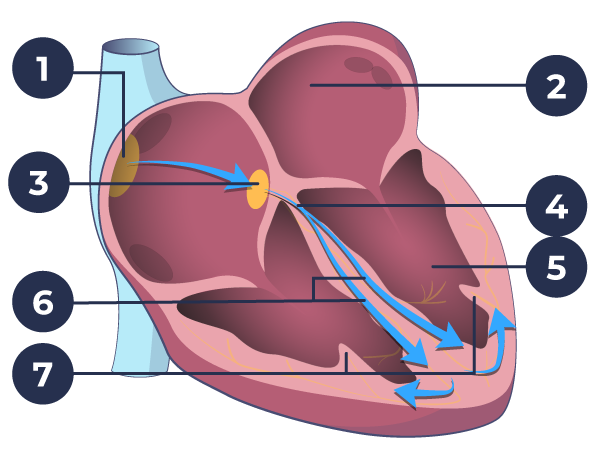The heart consists of four chambers – two atria (one atrium) and two ventricles (one ventricle). The heart simultaneously pump “old” deoxygenated blood through the lungs so that the blood can be supplied with new energy, or oxygen, while pumping “fresh” oxygenated blood into the rest of our body as “fuel.”
This process is typically illustrated with a blue side (the right atrium and right ventricle) and red side (the left atrium and left ventricle). The blue side receives deoxygenated blood and pumps it out towards the lungs via the pulmonary circulation. The red side receives oxygenated blood and pumps it out into the rest of the body.
The pump function is controlled via electrical impulses. The sinus node regularly sends signals out into the atria which causes the atria to empty into the heart chambers. The electrical impulses from the atria are then collected in the AV node and led through a “wiring system” into the heart chambers, signalling that they should contract and empty themselves.
Normally this process causes a pulse that fluctuates depending on our activity level, typically between 60 to 150 beats a minute. This correlates to about 100,000 heart beats a day. However, the exact number varies and some may have a lower resting heart rate, particularly if they are in really good shape. A healthy heart is able to maintain this rate like a clockwork for up to a 100 years – 3-4 billion beats – and we rarely give it a second thought.

- Sinus node
- Left atrium
- AV-node
- Bundle of His
- Left ventricle
- Right and left bundle branches
- Purkinje fibers
Sick sinus syndrome and AV block
Unfortunately, in some cases something goes wrong and too few or too many impulses can be sent from the atria into the heart chamber. If the sinus node emits too few impulses then a patient’s pulse can be too low. This is called sick sinus syndrome. Symptoms include fatigue, dizziness, and fainting. The condition can typically be remedied with a pacemaker.
It is also possible for the AV node to fail to transmit enough pulses. This is called AV block which can also lead to similar symptoms, such as fatigue, dizziness, and fainting. This condition can also be remedied with a pacemaker.
It is also possible for our heart rate to become too fast. This condition is generally called tachycardia (Greek: fast heart). There are various potential causes for this but the most common is called atrial fibrillation (AF).
When AF occurs the AV node is bombarded with electrical impulses, which means that it is incapable of properly regulating the heartbeat. Patients will experience symptoms including shortness of breath, becoming easily tired, a restless heartbeat, and the need to urinate more frequently. AF can be treated with medication, or with an ablation. Sometimes AF can get better through weight loss and exercise.
These conditions are all troublesome because they interfere with the normal functioning and regulation of the heart.
A functional left ventricle empties approximately 60% of the blood it contains at each heart beat. If the pumping power is reduced, this could lead to heart failure, or a decrease in the amount of oxygen reaching the rest of our body. This is why it is so important to take care of our hearts and ensure that we manage conditions like atrial fibrillation, AV block, and sick sinus syndrome.
1 comment